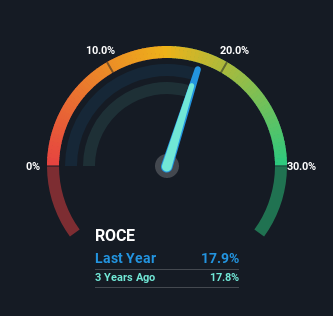- United States
- /
- Hospitality
- /
- NYSE:SIX
Six Flags Entertainment's (NYSE:SIX) Returns On Capital Tell Us There Is Reason To Feel Uneasy
To avoid investing in a business that's in decline, there's a few financial metrics that can provide early indications of aging. Businesses in decline often have two underlying trends, firstly, a declining return on capital employed (ROCE) and a declining base of capital employed. Basically the company is earning less on its investments and it is also reducing its total assets. In light of that, from a first glance at Six Flags Entertainment (NYSE:SIX), we've spotted some signs that it could be struggling, so let's investigate.
Return On Capital Employed (ROCE): What Is It?
For those who don't know, ROCE is a measure of a company's yearly pre-tax profit (its return), relative to the capital employed in the business. To calculate this metric for Six Flags Entertainment, this is the formula:
Return on Capital Employed = Earnings Before Interest and Tax (EBIT) ÷ (Total Assets - Current Liabilities)
0.18 = US$385m ÷ (US$2.7b - US$514m) (Based on the trailing twelve months to April 2023).
Therefore, Six Flags Entertainment has an ROCE of 18%. In absolute terms, that's a satisfactory return, but compared to the Hospitality industry average of 9.1% it's much better.
See our latest analysis for Six Flags Entertainment

In the above chart we have measured Six Flags Entertainment's prior ROCE against its prior performance, but the future is arguably more important. If you'd like, you can check out the forecasts from the analysts covering Six Flags Entertainment here for free.
SWOT Analysis for Six Flags Entertainment
- No major strengths identified for SIX.
- Earnings declined over the past year.
- Interest payments on debt are not well covered.
- Annual earnings are forecast to grow faster than the American market.
- Good value based on P/E ratio and estimated fair value.
- Debt is not well covered by operating cash flow.
- Total liabilities exceed total assets, which raises the risk of financial distress.
- Annual revenue is forecast to grow slower than the American market.
What Can We Tell From Six Flags Entertainment's ROCE Trend?
There is reason to be cautious about Six Flags Entertainment, given the returns are trending downwards. About five years ago, returns on capital were 25%, however they're now substantially lower than that as we saw above. On top of that, it's worth noting that the amount of capital employed within the business has remained relatively steady. Companies that exhibit these attributes tend to not be shrinking, but they can be mature and facing pressure on their margins from competition. If these trends continue, we wouldn't expect Six Flags Entertainment to turn into a multi-bagger.
The Key Takeaway
All in all, the lower returns from the same amount of capital employed aren't exactly signs of a compounding machine. Investors haven't taken kindly to these developments, since the stock has declined 58% from where it was five years ago. With underlying trends that aren't great in these areas, we'd consider looking elsewhere.
Six Flags Entertainment does have some risks though, and we've spotted 2 warning signs for Six Flags Entertainment that you might be interested in.
While Six Flags Entertainment may not currently earn the highest returns, we've compiled a list of companies that currently earn more than 25% return on equity. Check out this free list here.
New: Manage All Your Stock Portfolios in One Place
We've created the ultimate portfolio companion for stock investors, and it's free.
• Connect an unlimited number of Portfolios and see your total in one currency
• Be alerted to new Warning Signs or Risks via email or mobile
• Track the Fair Value of your stocks
Have feedback on this article? Concerned about the content? Get in touch with us directly. Alternatively, email editorial-team (at) simplywallst.com.
This article by Simply Wall St is general in nature. We provide commentary based on historical data and analyst forecasts only using an unbiased methodology and our articles are not intended to be financial advice. It does not constitute a recommendation to buy or sell any stock, and does not take account of your objectives, or your financial situation. We aim to bring you long-term focused analysis driven by fundamental data. Note that our analysis may not factor in the latest price-sensitive company announcements or qualitative material. Simply Wall St has no position in any stocks mentioned.
About NYSE:SIX
Six Flags Entertainment
Owns and operates regional theme and waterparks under the Six Flags name.
Moderate growth potential and slightly overvalued.
Similar Companies
Market Insights
Community Narratives



